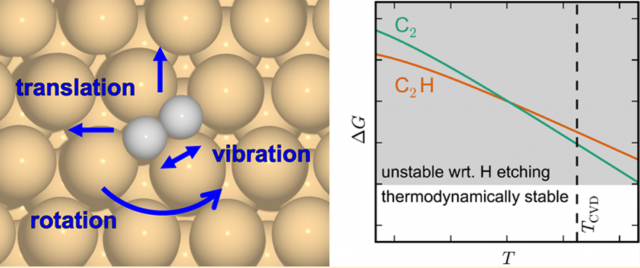Ab Initio Thermodynamics of Hydrocarbons Relevant to Graphene Growth at Solid and Liquid Cu Surfaces
| Title | Ab Initio Thermodynamics of Hydrocarbons Relevant to Graphene Growth at Solid and Liquid Cu Surfaces |
| Publication Type | Journal Article |
| Year of Publication | 2019 |
| Authors | Andersen M, Cingolani JSantiago, Reuter K |
| Journal | The Journal of Physical Chemistry C |
| Volume | 123 |
| Start Page | 22299−22310 |
| Abstract | Using ab initio thermodynamics, the stability of a wide range of hydrocarbon adsorbates under various chemical vapor deposition (CVD) conditions (temperature, methane and hydrogen pressures) used in experimental graphene growth protocols at solid and liquid Cu surfaces has been explored. At the employed high growth temperatures around the melting point of Cu, we find that commonly used thermodynamic models such as the harmonic oscillator model may no longer be accurate. Instead, we account for the translational and rotational mobility of adsorbates using a recently developed hindered translator and rotator model or a two-dimensional ideal gas model. The thermodynamic considerations turn out to be crucial for explaining experimental results and allow us to improve and extend the indings of earlier theoretical studies regarding the role of hydrogen and hydrocarbon species in CVD. In particular, we find that smaller hydrocarbons will completely dehydrogenate under most CVD conditions. For larger clusters, our results show that metal-terminated and hydrogen-terminated edges have very similar stabilities. While both cluster types might thus form during the experiment, we show that the low binding strength of clusters with hydrogen-terminated edges could result in instability toward desorption. |
| DOI | 10.1021/acs.jpcc.9b05642 |

